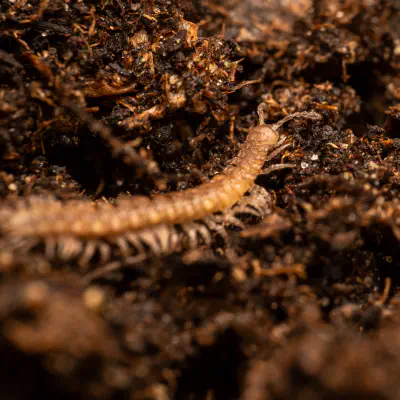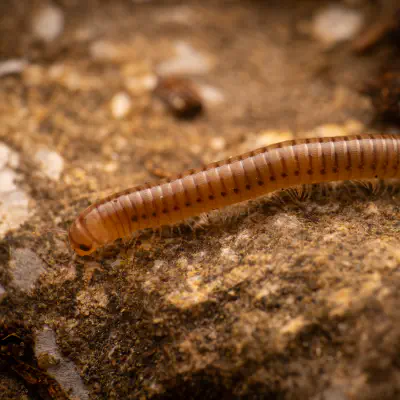Myriapods Lat. “Myriapoda“
Myriapoda is a subphylum of arthropods containing millipedes, centipedes, and others. The group contains over 16,000 species, most of which are terrestrial. Although their name suggests they have myriad (10,000) legs, myriapods range from having up to 750 legs (the millipede Illacme plenipes) to having fewer than ten legs.
Hierarchy
Anatomy
Myriapods have a single pair of antennae and, in most cases, simple eyes. Exceptions are the two classes of symphylans and pauropods, the millipede order Polydesmida and the centipede order Geophilomorpha, which are all eyeless. The house centipedes (Scutigera) on the other hand, have large and well-developed compound eyes. The mouthparts lie on the underside of the head, with an “epistome” and labrum forming the upper lip, and a pair of maxillae forming the lower lip. A pair of mandibles lie inside the mouth. Myriapods breathe through spiracles that connect to a tracheal system similar to that of insects. There is a long tubular heart that extends through much of the body, but usually few, if any, blood vessels. Malpighian tubules excrete nitrogenous waste into the digestive system, which typically consists of a simple tube. Although the ventral nerve cord has a ganglion in each segment, the brain is relatively poorly developed. During mating, male myriapods produce a packet of sperm, or spermatophore, which they must transfer to the female externally; this process is often complex and highly developed. The female lays eggs which hatch as much-shortened versions of the adults, with only a few segments and as few as three pairs of legs. With the exception of the two centipede orders Scolopendromorpha and Geophilomorpha, which have epimorphic development (all body segments are formed segments embryonically), the young add additional segments and limbs as they repeatedly moult to reach the adult form. The process of adding new segments during postembryonic growth is known as anamorphosis, of which there are three types: euanamorphosis, emianamorphosis, and teloanamorphosis. In euanamorphosis, every moult is followed by addition of new segments, even after reaching sexual maturity; in emianamorphosis, new segments are added until a certain stage, and further moults happen without addition of segments; and in teloanamorphosis, where the addition of new segments stops after the adult form is reached, after no further moults occur.
Ecology
Myriapods are most abundant in moist forests, where they fulfill an important role in breaking down decaying plant material, although a few live in grasslands, semi-arid habitats or even deserts. A very small percentage of species are littoral (found along the sea shore). The majority are detritivorous, with the exception of centipedes, which are chiefly nocturnal predators. A few species of centipedes and millipedes are able to produce light and are therefore bioluminescent. Pauropodans and symphylans are small, sometimes microscopic animals that resemble centipedes superficially and live in soils. Millipedes differ from the other groups in having their body segments fused into pairs, giving the appearance that each segment bears two pairs of legs, while the other three groups have a single pair of legs on each body segment. Although not generally considered dangerous to humans, many millipedes produce noxious secretions (often containing benzoquinones) which in rare cases can cause temporary blistering and discolouration of the skin. Large centipedes, however, can bite humans, and although the bite may cause intense pain and discomfort, fatalities are extremely rare.
Classification
There has been much debate as to which arthropod group is most closely related to the Myriapoda. Under the Mandibulata hypothesis, Myriapoda is the sister taxon to Pancrustacea, a group comprising the Crustacea and Hexapoda (insects and their close relatives). Under the Atelocerata hypothesis, Hexapoda is the closest, whereas under the Paradoxopoda hypothesis, Chelicerata is the closest. This last hypothesis, although supported by few, if any, morphological characters, is supported by a number of molecular studies. A 2020 study found numerous characters of the eye and preoral region suggesting that the closest relatives to crown myriapods are the extinct Euthycarcinoids. There are four classes of extant myriapods, Chilopoda (centipedes), Diplopoda, Pauropoda and Symphyla, containing a total of around 12,000 species. While each of these groups of myriapods is believed to be monophyletic, relationships among them are less certain.
See also
Euthycarcinoidea, a group of enigmatic arthropods that may be ancestral to myriapods Colonization of land, major evolutionary stages leading to terrestrial organisms Metamerism, the condition of multiple linearly repeated body segments
External links
Myriapod Fossil Record - University of Bristol International Journal of Myriapodology International Society of Myriapodology British Myriapod and Isopod Group Myriapods, the World’s Leggiest Animals - North America
Ancestry Graph
Further Information
„Myriapods“ on iNaturalist.org
Copyright

This article uses material from the Wikipedia article Myriapoda the free encyclopedia Wikipedia which is released under Creative Commons Attribution-ShareAlike 4.0 International License). On Wikipedia a list of authors is available.

Little beings in print
Order our calendars and books today!
Compiled with love. Printed sustainably. Experience our little beings even more vividly in print. All our publications are available for a small donation.



